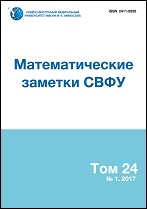|
This article is cited in 1 scientific paper (total in 1 paper)
Mathematical modeling
A mathematical model of ideal gas hydrate decomposition in a reservoir through decreasing pressure and simultaneous heating
V. V. Popovab
a Ammosov North-Eastern Federal University, 42 Kulakovsky Street, Yakutsk 67700, Russia
b Institute of Oil and Gas Problems of Siberian Branch of RAS, 1 Oktyabrsky Street, Yakutsk 677980, Russia
Abstract:
A mathematical model of the process of dissociation of hydrates coexisting in a thermodynamically equilibrium state in a reservoir by reducing the pressure and increasing the temperature in the gallery of wells is implemented numerically. It is shown that at certain values of depression and initial hydrate saturation, the value of the latter at the well approaches zero. A mathematical model developed by G. G. Tsypkin in 2009 is implemented numerically.
In the system of coupled heat and mass transfer equations, the energy conservation equation contains terms that take into account convective and conductive heat transfer, as well as the latent heat of the phase transition.
It is shown that at low values of initial hydrate saturation even strong enough heating has little effect on the dynamics of the moving boundary separating the region with phase transition from the area without phase transition. The results of numerical implementations are given in the form of graphs.
Keywords:
phase transition, thermodynamic equilibrium, thermal conductivity, water saturation, hydrate saturation, pressure, density, filtration, gas hydrates.
Received: 24.01.2019
Revised: 10.11.2019
Accepted: 27.11.2019
Citation:
V. V. Popov, “A mathematical model of ideal gas hydrate decomposition in a reservoir through decreasing pressure and simultaneous heating”, Mathematical notes of NEFU, 26:4 (2019), 83–97
Linking options:
https://www.mathnet.ru/eng/svfu273 https://www.mathnet.ru/eng/svfu/v26/i4/p83
|

| Statistics & downloads: |
| Abstract page: | 86 | | Full-text PDF : | 57 |
|




 Contact us:
Contact us: Terms of Use
Terms of Use
 Registration to the website
Registration to the website Logotypes
Logotypes








 Citation in format
Citation in format 
